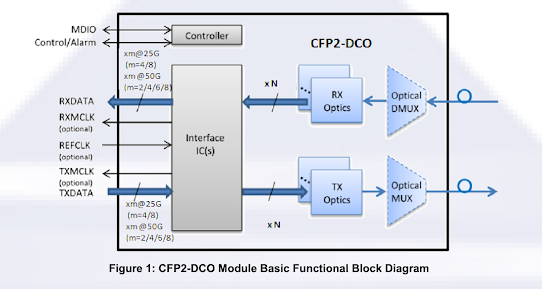Coherent DSP (Digital Signal Processor)
A coherent DSP (Digital Signal Processor) plays a crucial role in modern optical communication systems, especially those using coherent detection techniques. Coherent detection involves using both the amplitude and phase information of the received optical signal to extract transmitted data. A coherent DSP processes the received optical signal in the digital domain to recover the transmitted data accurately. Here's how a coherent DSP works:
Photodetection and Mixing: In coherent optical communication, the received optical signal is mixed with a local oscillator (LO) signal to generate an electrical signal. This process is known as photodetection. The LO signal is typically generated at the receiver and has a stable frequency and phase relationship with the transmitted signal.
Analog-to-Digital Conversion (ADC): The electrical signal generated by photodetection is analog in nature. The first step in coherent DSP processing is to convert this analog signal into a digital format using ADCs. This converts the continuous-time analog signal into discrete digital samples that can be processed digitally.
Sampling and Timing Recovery: The ADC samples the incoming signal at a high rate, capturing both the amplitude and phase information. Timing recovery algorithms within the coherent DSP help synchronize the received signal with the local oscillator's phase and frequency to ensure accurate demodulation.
Digital Signal Processing: The core of the coherent DSP involves various digital signal processing techniques applied to the digitized signal:
Carrier Phase Recovery (CPR): Since coherent detection relies on precise phase information, the DSP implements algorithms to estimate and correct the carrier phase offset introduced during transmission. This ensures that the received signal's phase aligns accurately with the LO phase.
Equalization: Optical signals can experience distortion due to fiber impairments. DSP algorithms perform digital equalization to correct these distortions, improving the signal quality and minimizing errors.
Polarization Demultiplexing: Coherent signals can carry two orthogonal polarization states. The DSP separates and processes these polarizations to extract transmitted data accurately.
Digital Mixing and Filtering: The DSP digitally multiplies the received signal by the local oscillator to shift the signal's frequency down to baseband. Filtering is applied to remove unwanted high-frequency components.
Data Demodulation: The processed signal is demodulated to extract the transmitted data symbols. This involves decoding phase and amplitude information to recover the original data symbols.
Signal Correction and Error Correction: The coherent DSP performs error correction and data correction techniques to address any residual errors introduced during transmission. Forward Error Correction (FEC) codes are often used to correct errors and enhance the signal's resilience.
Signal Decoding and Demultiplexing: The coherent DSP recovers the transmitted data symbols and decodes them into meaningful information, such as bits or bytes. If the transmission involves multiple wavelength channels (WDM), the DSP can also demultiplex the channels and separate the data streams.
Data Output: The processed and corrected data is provided as output, ready for further processing or routing within the optical network.
In summary, a coherent DSP is a critical component in coherent optical communication systems. It converts the received optical signal into a digital format, applies advanced digital signal processing techniques to accurately recover transmitted data, and corrects for various impairments introduced during transmission, ensuring reliable and high-capacity data communication over optical networks.


Comments
Post a Comment